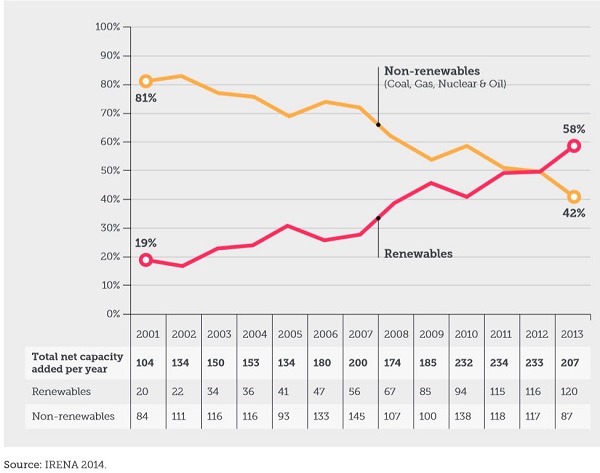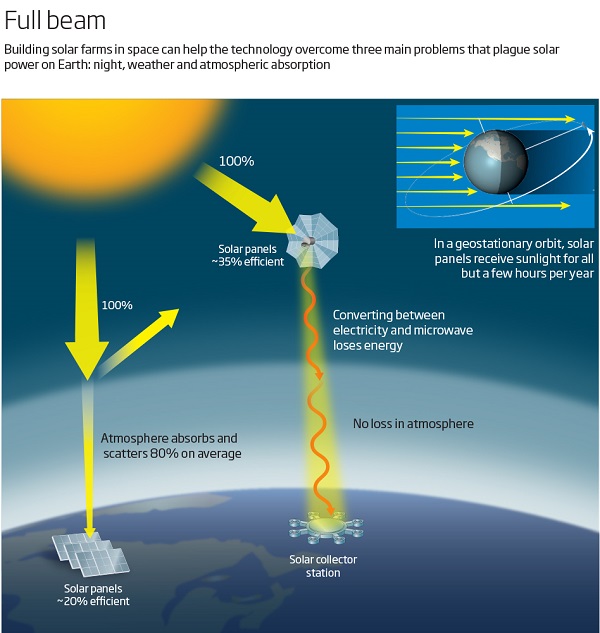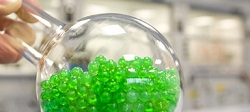In this post I’d like to identify a few technologies that are under development which go beyond the standard wind and solar. However, first I’ll link to a Climate Institute report prepared around the time of the Paris climate talks last year, which showed that in 2013 for the first time more new energy capacity was created in the form of renewables, rather than coal, gas, oil or nuclear. Back in 2001 renewables only accounted for 19% of new capacity. Now the proportion has reached 58% and is climbing steeply:

Space solar
The biggie is space solar (New Scientist-paywlled), produced in orbit 36,000 km above the earth’s surface. Placing the panels in space has three advantages. Firstly, there is no night, power would be offline only a few hours each year.
Secondly, there is no problem with clouds.
Thirdly, the sun’s rays are not dissipated by the atmosphere. Apparently even on the brightest day power can be reduced to between a third and a 20th.
The power would be transmitted by microwave to an earth collecting station.
The big problem is the cost of launching all the kit necessary to do the job. Work is concentrating on making it lighter, possibly less than one centimetre thick. One of the projects reckon they can do it with only three large rocket launches.
Projects are underway in California, Japan, China and Russia. There may be pilot projects in the next few years, but the Japanese are aiming at “fully operational satellites delivering 1 gigawatt in the 2030s.” The suggestion is that eventually the satellites can be scaled up to 10 gigawatts each. By equipping them with widely available beam-steering equipment you could have 1000 satellites beaming on one collection point. The ambition is to produce 10 terawatts, or more than half of world’s present capacity.
Here’s the concept image:

Flying with hydrogen
The New Scientist has a story on the first flight using hydrogen pellets. There’s more at Cafe Foundation.
The flight in this case was a Raptor UAS drone, loaded with 100 small pellets. The flight was only 10 minutes, but could have been two hours. Pellets are lyophilized, or freeze dried, to keep the stored hydrogen in place at room temperature:

Each pellet contains one litre of hydrogen. The energy density is about three times the best lithium-ion batteries.
The first use may be in climate data collection drones. With hydrogen they can stay in the air longer and only produce water vapour in the exhaust, hence not polluting the samples.
Another version of the technology uses millimetre-sized pellets that can be pumped like a liquid fuel.
The technology is scalable and could be used for light aircraft and beyond.
Making liquid hydrocarbon fuels in one step
On the post Saving the planet Bilb linked to an article about making liquid hydrocarbon fuels in one step:
- University of Texas at Arlington chemists and engineers have converted carbon dioxide and water directly into useable liquid hydrocarbon fuels – in one step. The “simple and inexpensive new sustainable fuels technology” used concentrated sunlight, high pressure and heat to remove CO2 from the air and even revert oxygen back into the system.
I’ll leave you to read the story for technical details.
Back in 2014 John Davidson did a post on the US Navy producing fuel from seawater.
John also has a post at Pragmatus J on making renewable fuels from inorganic processes.
OMEGA Project
Bilb also linked to the NASA Omega Project:
- Offshore Membrane Enclosures for Growing Algae (OMEGA) is an innovative method to grow algae, clean wastewater, capture carbon dioxide and to ultimately produce biofuel without competing with agriculture for water, fertilizer or land.
NASA’s OMEGA system consists of large flexible plastic tubes, called photobioreactors. Floating in seawater, the photobioreactors contain freshwater algae growing in wastewater. These algae are among the fastest growing plants on Earth.
The algae use energy from the sun, carbon dioxide and nutrients from the wastewater to produce biomass that can be converted into biofuels as well as other useful products such as fertilizer and animal food. The algae clean the wastewater by removing nutrients that otherwise would contribute to marine deadzone formation.
This list is not exhaustive. I’ve just gathered a few ideas thrown up in the past week or so.


Clean power, we need as much as we can get, but then what to do with it.
There is a lot of information in this article
http://www.greencarreports.com/news/1102624_hyundai-ioniq-most-important-car-at-the-geneva-motor-show
…take note of the various programs in other countries to “guide” vehicle supply towards low or zero emissions.
On the whole good news for a change, Brian, thanks!
The skeletons in a few of these cupboards will emerge a bit later perhaps. This will hopefully help pay future generations for the horrendous I.O.U.s issued by atomic energy.
Chr. J.